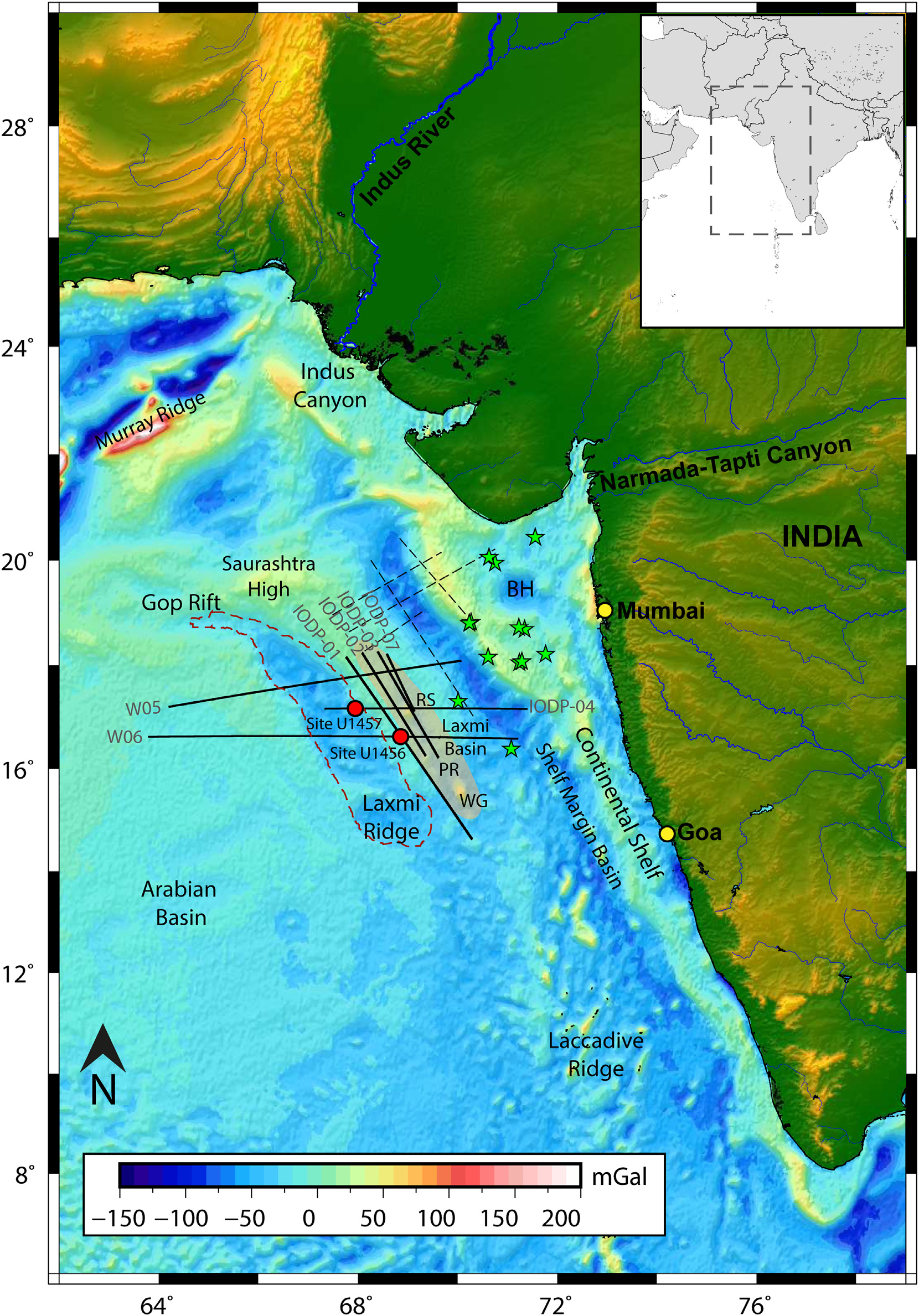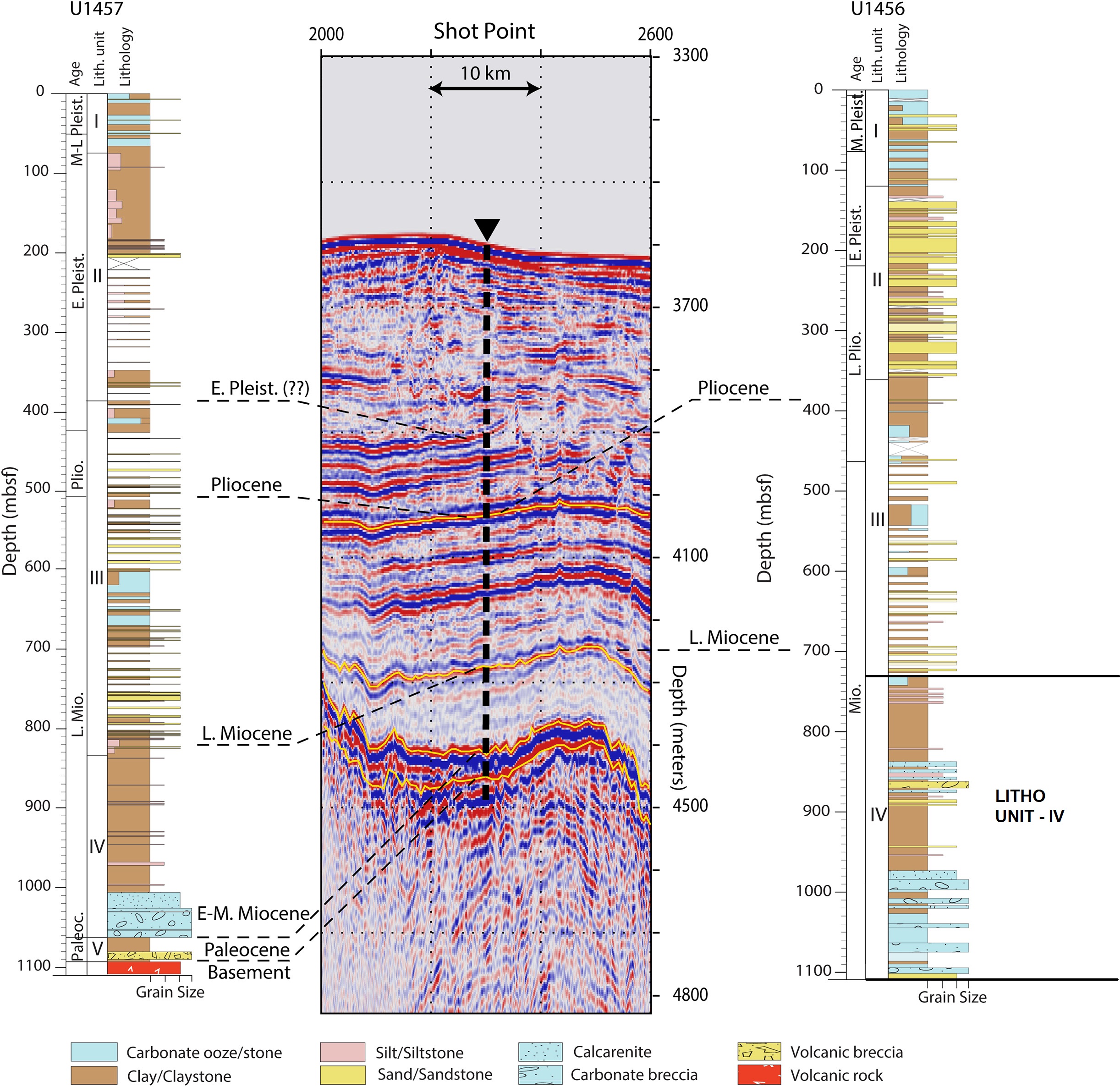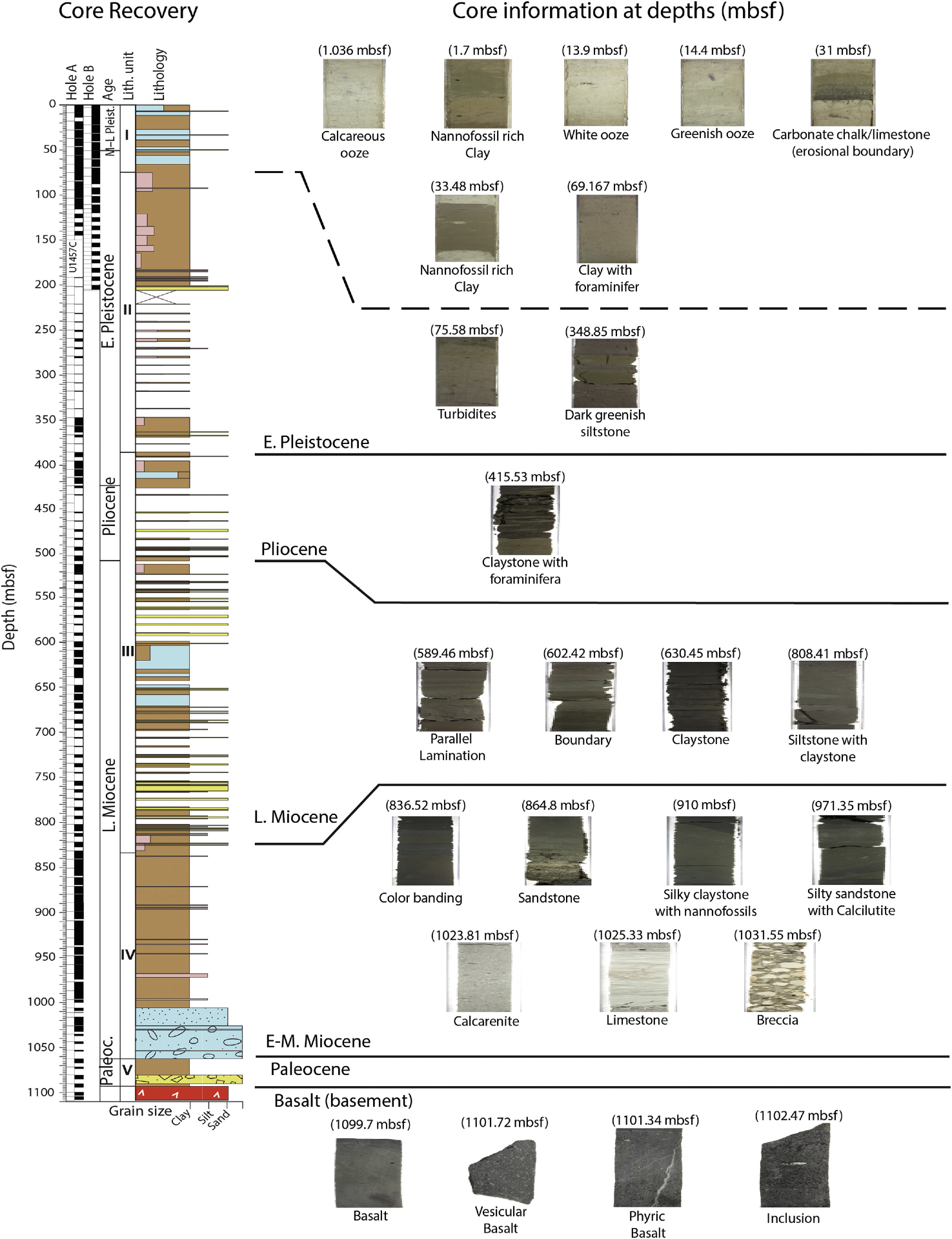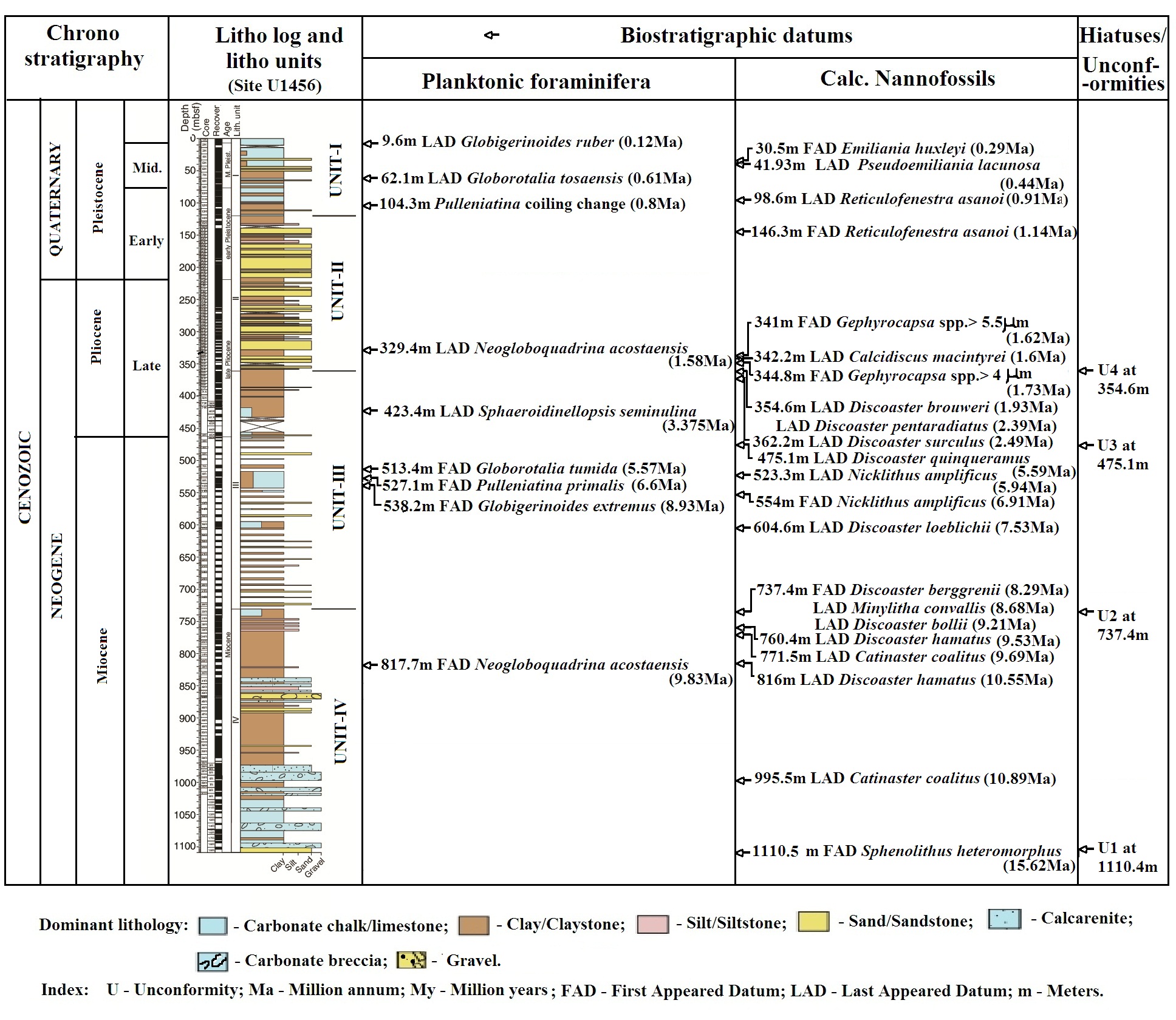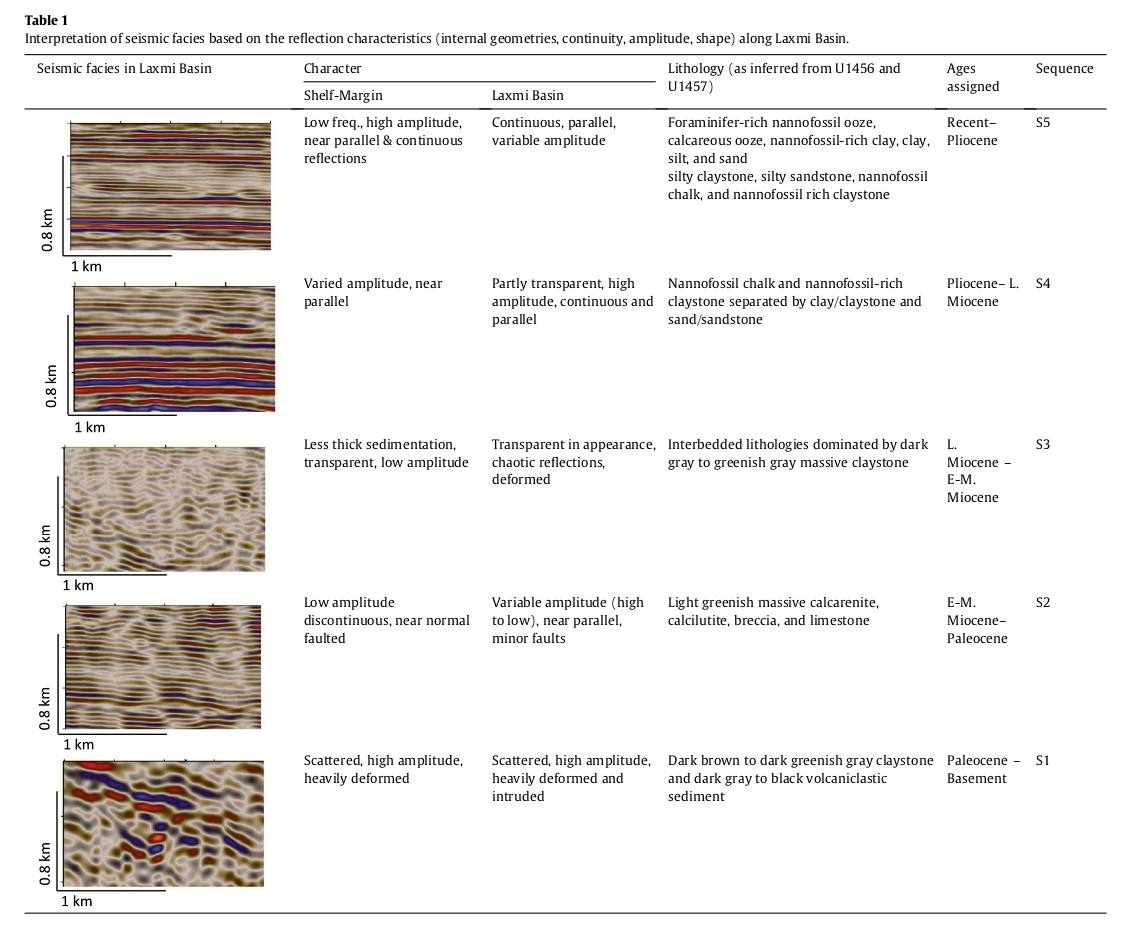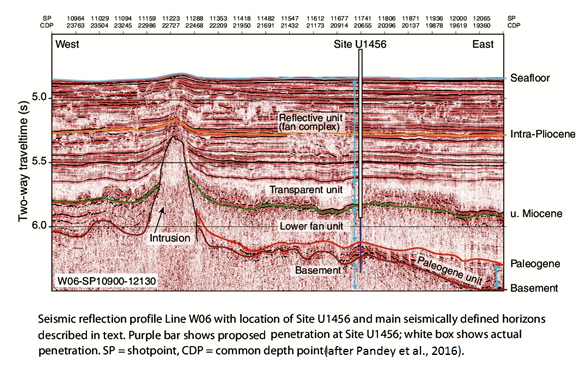Laxmi Basin Informal Lithounit IV Fm
Type Locality and Naming
Type section (reference well) is in Site U1456, 730-1100 mbsf. [Original Publication: D.K. Pandey, P.D. Clift, D.K. Kulhanek and the Expedition 355 Scientists. (2016). Proceedings of the International Ocean Discovery Program, Vol. 355. Publications.iodp.org]
[Figure 1: Regional free air gravity anomaly map of the western Indian Ocean with mainland topography. The area of study is shown in the inset regional map. Superposed are the major tectonic elements (in black) and locations of seismic profiles (solid black lines) used for the present study. Drill locations of IODP Expedition 355 used to compare the litholog data with seismic sequences are marked in red circles. Green stars denote the location of the exploratory wells (NELP 2007) from the near shelf region. Demarcation of Laxmi Ridge from free air gravity anomaly response is denoted in red dashed lines. The interpretation from seismic profiles IODP-02, IODP-03, IODP-07, W05 and W06 are utilized as constraints for the present study and incorporated to generate the isopach map. The black dashed lines are the locations of published seismic profiles (Pandey et al., 2017; Nair and Pandey, 2018). The distribution of rivers in the Indian mainland is shown in blue. BH- Bombay High; RS- Raman Seamount; WG-Wadia Guyot, PR- Panikkar Ridge. The extent of PR modified from Pandey and Pandey (2015), (after Nisha Nair et al., 2021)]
[Figure 2: Calibration of seismic horizons with sediments recovered from Sites U 1456 and U1457 (Pandey et al., 2016) in the Laxmi Basin. Seismic reflection profile IODP-04 crossing across drill site U 1457 shows the reflection configuration and correlated age from cores. Ages are assigned from the nannofossil biostratigraphic markers (IODP Expedition 355) using the geological time-scale (Gradstein et al., 2012), (after Nisha Nair et al., 2021)]
[Figure 3: Main sedimentary features corresponding to dominant lithology of each interpreted sequence from SiteU1457. The descriptions and depth of the cores are taken from the core log report of IODP Expedition 355, after Nisha Nair et al., 2021)]
Lithology and Thickness
Limestone. Lithounit IV consists mainly of four lihtologies: 1) Light greenish calcarenite and calcilutite, 2) Dark gray claystone, 3) Breccia and conglomerate and 4) Light brownish to whitish limestone.
Dark gray massive claystone, light greenish calcarenite and calcilutite and breccias / conglomerate are dominant in the upper part of this lithounit. In the lower part of this lithounit, limestone and breccias are most abundant, with interbedded calcarenite, calcilutite and claystone. The dark grey claystone is mostly massive and is marked by light brownish to light greenish interbeds of nannofossil rich claystone, nannofossil chalk and siltstone. Various colors of claystone, including dark brown, light blue and pale blue occur between 1011.5 and 1012.49 mbsf. The bluish claystone is very rich in smectite as determined by XRD analysis.
Thick to very thick beds of fine to medium grained calcarenite and calcilutite with nannofossils and foraminifers occur only below 837.10mbsf. Calcarenite and calcilutite also show reverse grading from medium grained calcarenite at the top of a given bed and very fine grained calcilutite at the bottom. The boundary between calcarenite or calcilutite and dark gray claystone is normally sharp and erosive. Breccia is dominated by subangular to subrounded carbonate clasts, small clasts of claystone and weathered volcanic material.
Lithounit IV shows diverse structural features such as microfaults, folds, slickensides and inclined to vertical bedding. Pressure induced sedimentary structures are observed within limestone. Sedimentary structures caused by loading pressure. In Lithounit IV the most common minerals are quartz and mica with very rare or trace amounts of heavy minerals. Its thickness is at Hole U1456D = 287.76.70 m and Hole U1456E = 134.52m (minimum thickness); Intervals – Hole U1456D = 730.70 - 1018.46mbsf (total depth) and Hole U1456E = 970.0 - 1104.52mbsf (minimum).
Relationships and Distribution
Lower contact
Unconformity to Laxmi Basin Informal Lithounit V Fm
Upper contact
This lithounit boundary is marked by brownish gray silty claystone along with silty sandstone at the base of Laxmi Basin Informal Lithounit III Fm overlying the greenish gray nannofossil chalk and dark gray claystone of Unit IV.
Regional extent
GeoJSON
Fossils
All the foraminiferal and calcareous datums given in table below:
[Figure 4: Biostratigraphic datums of Site U1456]
Age
Depositional setting
Additional Information
[Figure 5: Interpretation of seismic facies based on the reflection characteristics (internal geometries, continuity, amplitude, shape) along Laxmi Basin, (after Nisha Nair et al., 2021)]
[Figure 6: Seismic reflection profile line W06 with location of Site U1456 and main seismically defined horizons described in text. Purple bar shows proposed penetration at Site U1456; white box shows actual penetration. SP = shotpoint, CDP = common depth point (after Pandey et al., 2016)]
